WP2 - Properties of waste materials
Work Package 2 is divided into seven sub-packages, WP2.A to WP2.G.
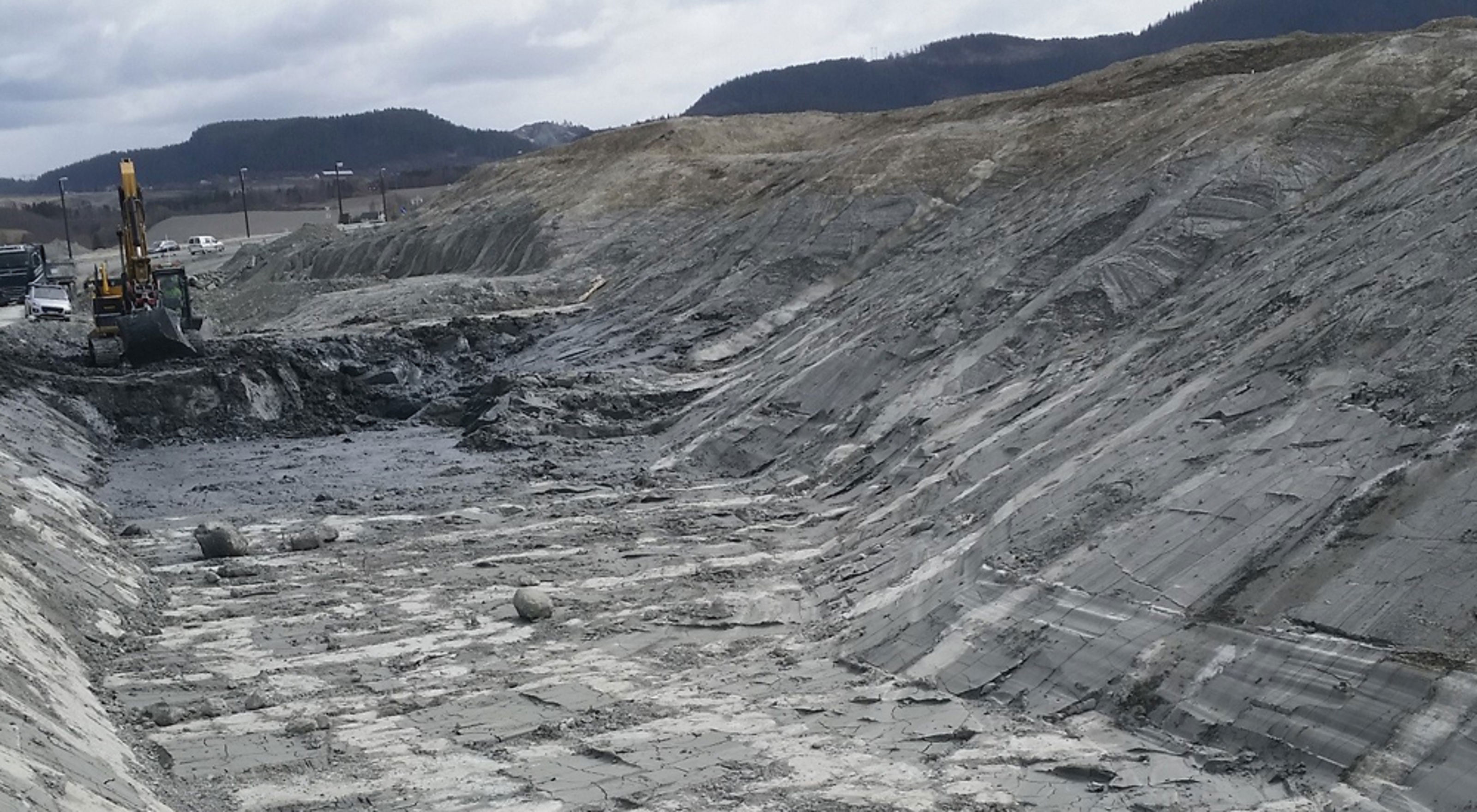
WP 2.A - Relevant test methods for geotechnical and geochemical characterization
This sub-package will investigate appropriate geotechnical and geochemical test methods that may be relevant to increase the reuse of waste and surplus materials.

Tests that can measure long-term stability chemically and physically (resistance, effectiveness of treatment) for the materials currently need to be included. These methods are needed for the virgin materials and those following chemical or mechanical treatment.
One activity in WP2.A will be the development of a method that allows both permeability and contaminant leaching in one test, as current methods only allow for two separate tests to be carried out. Such a combined method will enable the geochemical and hydrogeological effect of, for example, compression of the materials to be investigated. The test will be developed in NGI's geotechnical laboratory based on experience with permeability testing on residues.
Furthermore, methods will be developed to investigate the effect of freeze / thaw processes and drought / moisture absorption (physical weathering) of the material to be reused.
WP2.A will also include the development of strategies and methods using passive sampling of organic and inorganic contaminants, which allow bioavailability and environmental risk to be assessed.
WP 2.B - Reuse of slag
Slag from the metal industry, the waste incineration and the biofuel sector often has a very high metal content, which is therefore considered a waste material.
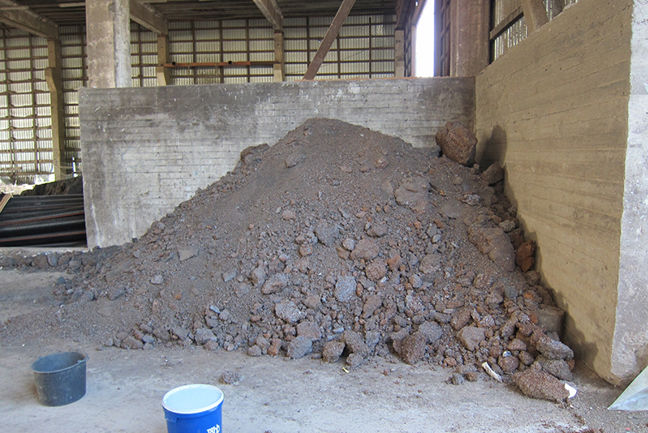
However, the geochemical properties of slag make it suitable for use as a chemical stabilisation material. Slag often has a chemical composition that allows pollutants to bind strongly to its structure and/or can act as a neutralisation agent.
In addition, slag can have geotechnical properties that allow it to be reused in various constructions (to aid drainage for example). This means that reuse possibilities exist, and by exploiting them, the volume of slag that would need to be transported and disposed of at landfill sites, reduced significantly.
WP2.B will focus on slag as a stabilisation material, and tests will be carried out where it will be mixed with, amoungst others, low level contaminated soil to assess the effect of the binding of pollutants. Both batch and column tests will be carried out, the slag will be extracted, and the mineral content will be analysed. Field experiments will also be carried out. Geochemical tests that measure strength, permeability and grain size distribution will be used.
This sub-package will be carried out in collaboration with NMBU researchers, those in the waste sector, and those that produce slag.
WP 2.C - Biochar: a sustainable sorbent against soil pollution?
Biochar can be made from low level contaminated waste timber by heating it without oxygen.
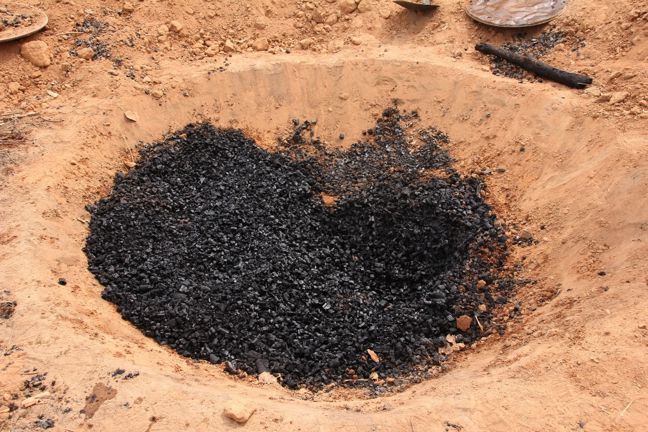
By mixing such biochar into contaminated soil, two large advantages are felt: the carbon is stored in a stable form and thus removed from the atmosphere, mitigating climate change, and contaminants are rendered unavailable for uptake in organisms, abating pollution problems.
This concept of remediating one waste stream (contaminated soil) by a smartly engineered form of another waste stream (waste timber) will be tested in collaboration with the recycling community.
In earlier projects, we have found that addition of activated carbon to soils contaminated by Polycyclic Aromatic Hydrocarbons (PAHs) strongly reduces pollutant leaching from the soil, and reduces uptake of the PAHs in plants and soil-dwelling animals such as earthworms.
In this sub-package, we will investigate whether this concept can be extended to biochar and soil pollution in the form of metals and perfluorinated compounds:
Can biochar from waste timber, possibly enriched with iron, reduce the leaching of heavy metal pollutants (especially Cu, Pb and Sb) from shooting range soils?
Can biochar from waste timber reduce the leaching of perfluorinated compounds from soils contaminated by fire drilling exercises with fire fighting foams containing these compounds?
WP 2.D – Lime/cement stabilised clay
The stabilization of clay with lime or cement provides a method to increasing load bearing capacity and slope stability for soft and quick clay used in construction projects. In ditches, trenches and buildings, parts of the stabilized clay are removed, and piles are used instead, covering areas ranging from 20% to 100% of the construction.
The removed soft and quick clay is often sent to inert landfills, but can be challenging to handle owing to geotechnical properties. Stabilizing these piles with lime or cement represents an effective, however relatively expensive, stabilization method.
The production of lime and cement are both energy-intensive processes with large carbon footprints. Therefore by reusing stabilized materials, benefits will be more significant as resource use is decreased, CO2 emissions are lower and less material will need to be send to landfills.
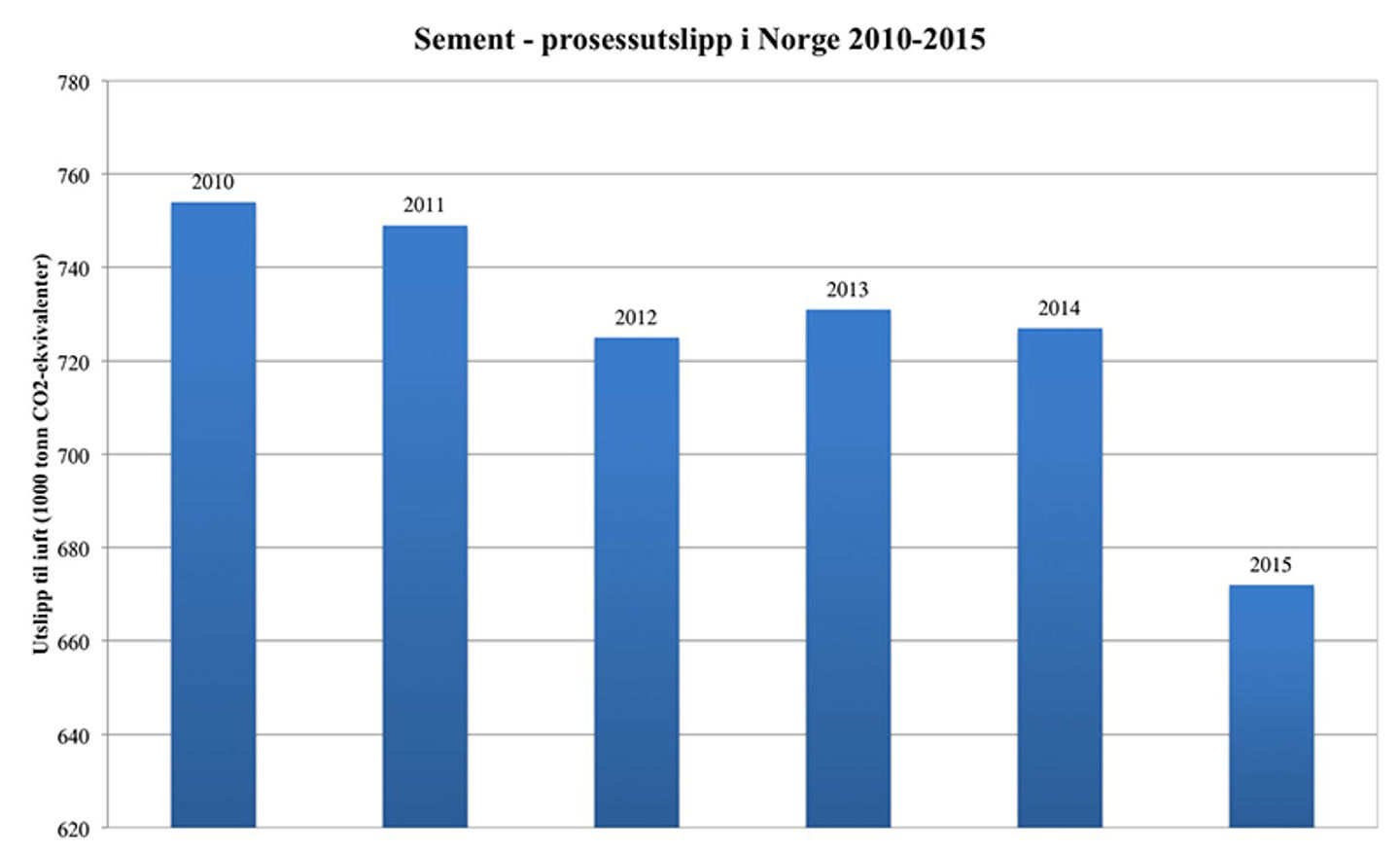
CO2-release during production of cement in Norway 2010-2015
This sub-package will begin with a review of the amounts of binder needed to obtain a material that can be handled easily. The geotechnical properties of the material will be investigated, as well as chemical changes caused by the hydration of lime and cement addition.
Short and long term permeability will be tested, and properties such as shrinkage and drying will be measured. Possible uses will be identified for the stabilized material, such as a top seal in landfills.
Initial tests have shown that the shear strength of the stabilized material can be > 40 kN / m2, and this is considered suitable for landscaping and in noise reduction applications. With this shear strength, the material can be transported and deposited differently than under todays practice.
WP 2.E - Low level contaminated soil
Large scale construction and building projects often result in a surplus of materials, soil, sediment or concrete.
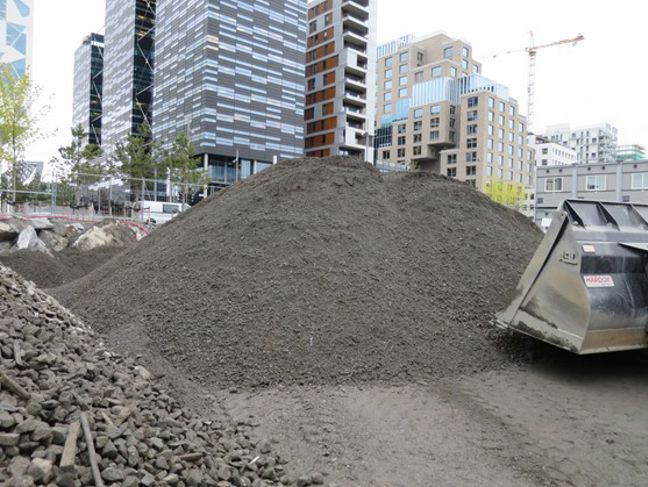
Current legislation related to the use and reuse of low level contaminated soil in building and construction projects does not allow for the movement of such material from one site to another. This can be regardless of the fact that the low level contaminated soil fulfills the designated reuse criteria for the site the material is intended to be moved to.
The Norwegian Environment Agency has recognized that this is a common and often very costly problem in large projects. There are no clear guidelines and methods that currently exist in order to assess the risk that such low level contaminated soil poses to the surrounding environment if it is moved from one site to another. As such finding solutions to this problem are severely hampered.
This sub-packageaims to address this by carrying out laboratory test that can be used in order to assess the risk of pollutant release and dispersion in to the environment from low level contaminated soil. Results will be used in order to assess whether one can move low level contaminated soil from one site to another.
Tests will be carried out using soils contaminated with common pollutants (oil, PAHs and heavy metals at lower concentrations) and that have variable physical characteristics (grain size distribution). The soils will be characterized for the total pollutant concentration, the pollutant fraction that can be released from the soil, the organic matter content and various physical parameters.
In addition WP2.E will investigate whether physical and chemical stabilization can be used a method to reduce the risk of pollutant release from the soils. The tests will be carried out in order to document the effect of material compaction and the addition of activated carbon on the release of pollutants.
External project partners in this sub-package will be Skien kommune, OBOS, Avinor and Veidekke.
WP 2.F - Waste materials from the mineral industry
Extraction and processing of various minerals and raw mineral materials is an important national and international industry. The use of minerals in various applications is vast and can range from gravel to paper, food, electronics and even makeup. An essential prerequisite for the high-tech development we see in today's society is access to specific elements and minerals. Super pure quartz, titanium ore and rare earth elements are essential mineral raw materials.
Thus, the mineral industry is central to the so-called "green shift" in a more circular and sustainable economy in Norway and internationally. In addition to producing highly sought after elements and minerals, the mineral industry also generates vast amounts of surplus mass.
In Norway the volume of the surplus mass can reach millions of tons a year. Such surpluses may be excess masses removed to reach a current mineral resource, or they may be surplus materials after processing and processing of raw materials.
A typical environmental challenge is associated with such surpluses regardless of origin: What should we do with them? Such masses are often stored in local hills or landfills on land or at sea. But is this the best management of these masses - or do they represent a value towards potentially new application areas?
GEOreCIRC's subproject linked to surplus masses from the mineral industry aims to map the recycling and refinancing potential of various types of surplus mass.
The results obtained will provide a better understanding of both chemical and physical properties the masses have, as well as a better understanding of the potential markets that exist for this type of mass. Furthermore, understanding of existing economic, practical and logistical constraints for such reuse is essential to enabling the exploitation of these enormous resources towards a circular economy.
WP 2.G – Material from tunnel construction
Several projects were carried out in the 1970s and 80s, where tunnels were drilled for hydroelectric plants. Several large infrastructure projects are being carried out, which are planned when tunnels will be drilled for road and rail development.
Tunnel drilling machines (TBM) are used in these more significant projects to remove a large volume of material to make way for the tunnel. If this material can be reused, the resources that could be saved are enormous.

The way the TBM operates results in drill cuttings with a smaller proportion of particles above 60 mm and a more significant fraction of very fine particles (<0.074 mm up to a content of 20%) compared to conventional rock blasting methods. The high proportion of very fine particles makes reuse challenging, as the cuttings are water-sensitive and can potentially undergo subsidence when used as filling materials.
The material could be used in noise barriers or landscaping where subsidence is not a significant problem. One current case study relevant to WP2.G is the Folloban Project, where tunnel cuttings will be used as a fill material to create a building platform for the new district Gjersrud/Stensrud in Oslo.
WP 2.G proposes guidelines for the types of laboratory and field tests that should be performed to assess whether TBM surplus cuttings can be reused as building block filling materials. In WP2.G, previous assessments of TBM masses carried out in connection with power plant developments will be compared to assessments of the material from the Folloban project.
Current laboratory methods that can be used to characterise the materials properties are water content, grain size distribution, mineralogical investigations, degradation tests, permeability and capillarity tests, Standard Proctor trials, and tri axial trials. Tests will also be carried out to assess the materials' leaching potential, especially in cases where there are diesel and oil spills from the tunnel drill.
In the Folloban project, where the drill cuttings will be used as a building platform, it will be necessary to compact them before use. In the later part of WP2.G, the need for layered deployment and compression using several different pieces of compression equipment and design will be evaluated to assess the cost benefit of material reuse.
WP 2.H – Reuse of concrete waste
In February 2020, the Norwegian Environmental Agency increased hexavalent chromium's threshold limit value guidelines from two to eight milligrams per kilo of concrete.
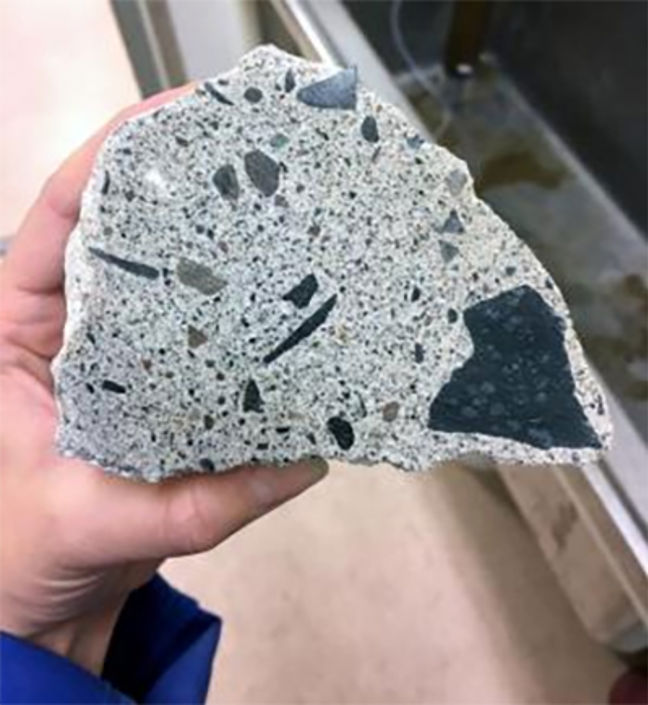
Scientists at NGI have been essential contributors providing influential knowledge on the behaviour of hexavalent chromium in nature.
One of the main reasons for the low recycling rate of concrete waste in Norway is low threshold limit value guidelines of hexavalent chromium (Cr-VI) in concrete. The value limit is set by the Norwegian Environmental Agency.
-The goal has been to recycle 70 percent of building and construction material by 2020. In reality, only 30 percent has been reclaimed by the end of 2019, says Cathrine Eckbo, project manager at NGI.
Hexavalent chromium
-Concrete consists mainly of cement, water, sand, gravel and stone. Cement is made of limestone that contains much of the element chromium (Cr). The process of making cement creates conditions where the chromium is mainly present in its more toxic hexavalent form, explains Eckbo.
One of the requirements of recycling concrete in Norway is that the Cr-VI concentration must be within the threshold limit value set by the Norwegian Environmental Agency. This value was set at two milligrams per kilo concrete.
-Due to the general high level of Cr-VI in concrete, most of the concrete was disposed of in landfills rather than being recycled. In February 2020, The Norwegian Environment Agency announced that the threshold limit value guidelines were increased from two to eight milligrams per kilo of concrete. This could make it easier for future projects aiming to recycle concrete, says Eckbo.
Revolutionary research
Scientists at NGI have been essential contributors in this process. Preliminary tests show that most chromium in the concrete leachate is hexavalent. Still, when the leachate comes into contact with soil containing a certain amount of organic material, the chromium is reduced by nearly 100%.
NGI and partners are currently working on further exploring these findings to be able to set environmentally safe threshold limit value guidelines of hexavalent chromium in concrete and, at the same time, ensuring an increased concrete recycling rate as well as promoting a circular economy.
